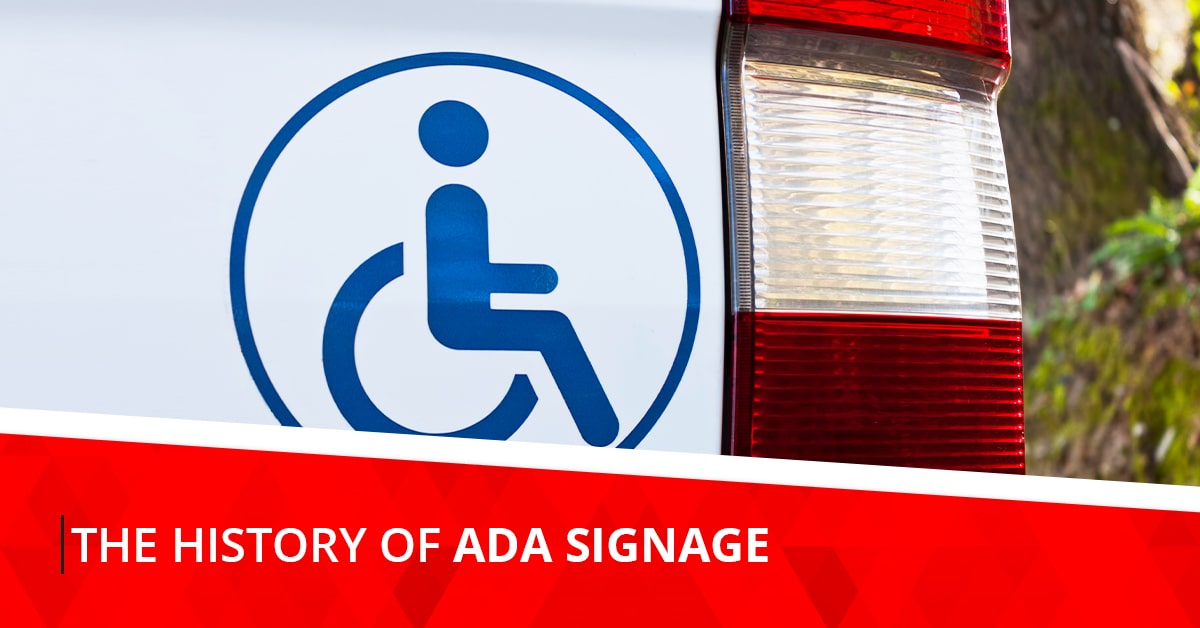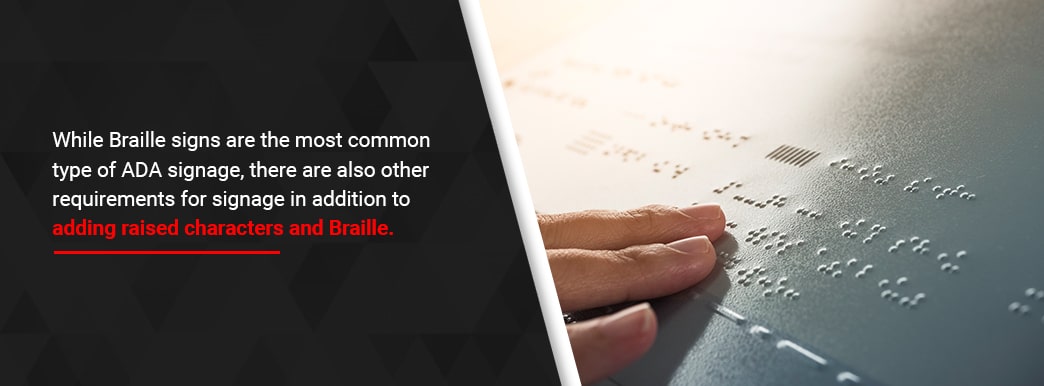
The History of ADA Signage
JULY 29, 2021| SpeedProCategories
SignageThe Americans with Disabilities Act (ADA) is one of the most important pieces of civil rights legislation in U.S. history. With this act, the government ensures businesses and organizations don’t discriminate against people with disabilities. The law also guarantees various rights for people with disabilities to ensure they can fully participate in American life. If you have a business or other public organization, you’ll want to know the history of ADA signage and its main rules. You might also be interested in learning more about the four types of ADA signs to ensure you’re meeting regulations.
What Is ADA Signage?
ADA signage refers to signs designed to meet regulations from the Americans with Disabilities Act. One major part of the ADA provides guidelines for governing commercial building access and public facility accommodations, including accommodations for room and building signage. Since the ADA requires that every permanent area, space or room in or around a public building has signage, you’ll see ADA signage in virtually every business you visit in person.
ADA Signage History
Though President George H.W. Bush signed the ADA into law on July 26, 1990, the fight for equal rights for people with disabilities began long before. Until the 1960s, people with disabilities were largely overlooked, and the disability rights movement was small and local. However, it began to grow in prominence after injured veterans of World War II came home and started lobbying for medical care.
In the 1960s, activists began to put pressure on the government to create more accessible spaces. At the time, many physical barriers stopped people with disabilities from accessing buildings, such as a lack of ramps for people who use wheelchairs, signs without Braille and difficult-to-access public restrooms.
After lobbying throughout the 1970s for changes, the disability rights movement finally pressured the federal government to pass Section 504 of the 1973 Rehabilitation Act. This section prevented discrimination based on disability for organizations receiving federal funding. This act also led to the creation of the Architectural and Transportation Barriers Compliance Board, which required public services to provide equal access.
While these victories helped those with disabilities, the disability rights movement wasn’t finished. The National Council on Disability sent recommendations to Congress in 1986, outlining what they wanted to see in an act that would focus on people with disabilities. In 1988, based on these recommendations, lawmakers introduced the ADA to the 100th Congress. After revision in 1989, it was introduced to the 101st Congress, with the Senate passing it. In 1990, the House passed it, and shortly after, the president signed it into law.
This act had a huge impact on ensuring people with disabilities had the same opportunities as able-bodied individuals. The law applies to a person’s ability to purchase goods and services, have employment opportunities and participate in local and state government services and programs. Essentially, the ADA is designed to improve accessibility for people with disabilities. A key portion of this act focused on creating ADA room signage to help those with disabilities better navigate buildings.
How Do ADA Standards Apply to Signage?
Since the act’s signing in 1990, the ADA’s signage requirements have evolved somewhat. The American National Standards Institute (ANSI) A117.1 Committee determines the signage requirements, with standards up for revision every five years. The most recent major evolution in ADA standards for signage occurred in 2010 when the Department of Justice submitted the 2010 ADA Standards of Accessible Design, which revised rules for Title II and Title III facilities. In 2012, these regulations became legally enforceable.
Based on the ADA’s new standards, businesses and organizations must meet a few ADA signage requirements. These ADA accessibility guidelines and regulations ensure signage is placed in convenient locations and can be easily read, either visually or through touch. The most common example of ADA signage is Braille signs, which assist people who are blind or visually impaired.
While Braille signs are the most common type of ADA signage, there are also other requirements for signage in addition to adding raised characters and Braille. For example, ADA requirements determine whether signs are required in certain areas. Other standards govern details like spacing and fonts. Additionally, the ADA has regulations stating where signs must be placed and some restrictions detailing where businesses or organizations can’t install their signs.
The ADA’s regulations apply to most signs defined as “architectural,” and this signage has to follow at least one of the ADA guidelines. Signs that must comply with ADA regulations include signage that:
- Informs about, identifies or directs to a facility’s accessibility features.
- Informs about or directs to a facility’s functional spaces.
- Identifies a permanent space or room in a facility, including the exits.
While many signs fall under ADA guidelines, signage designed for marketing or advertising applications does not. Additionally, temporary signs and signs or sections of signs featuring company names and logos don’t need to comply with ADA standards.
Examples of ADA-Compliant Room Signage
If you want to ensure people with disabilities can easily navigate your building and keep your company compliant with the law, you may want to know some of the top examples of ADA room signs. These are the four main types of ADA signage for rooms:
- Identification: Signs that identify an area, space or room are considered identification signs and fall under ADA standards. For example, ADA bathroom signage is a type of identification signage, as it helps people with disabilities locate restrooms. ADA bathroom signs and other identification signs must have Braille and meet various other requirements.
- Informational: Information signs are designed to give people information about a space, area or room. This ADA room signage doesn’t require Braille, but it must meet other requirements, such as high-contrasting colors and a non-glare finish.
- Directional: If a sign provides people with directions to an area, room or space, it falls under ADA directional signage requirements. Wayfinding signage must have a simple or sans serif font and feature high-contrasting colors, among other requirements.
- Overhead: Overhead signs refer to any projection, ceiling or wall-type sign mounted overhead. An example of this kind of signage would be emergency exit signs. Like information and directional signs, they don’t need to have Braille, but they must be non-glare and feature high-contrasting colors.
Choose SpeedPro for Your ADA Signage Needs
If you’re looking for ADA-compliant room signage, SpeedPro can help. As the only nationwide network of studios specializing in large format graphics, we can help you create attractive signage meeting ADA standards. We can even craft Braille signage and provide you with tips for how you can use signage to make your business more inclusive.
Take a moment to learn more about how we can provide you with ADA signage. If you’re ready to partner with us or have any questions, find your local SpeedPro studio, and one of our representatives will be happy to assist you.


















